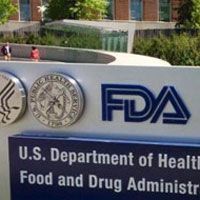Frontline Pembrolizumab Approved for NSCLC
The FDA has granted an accelerated approval to pembrolizumab (Keytruda) for use in combination with pemetrexed plus carboplatin as a frontline treatment for patients with non-small cell lung cancer (NSCLC).
Frontline Pembrolizumab Approved for NSCLC

The FDA has granted an accelerated approval to pembrolizumab (Keytruda) for use in combination with pemetrexed plus carboplatin as a frontline treatment for patients with metastatic or advanced nonsquamous non—small cell lung cancer (NSCLC), regardless of PD-L1 expression.
The approval was based on part 2 of cohort G in the KEYNOTE-021 trial, in which the pembrolizumab triplet elicited an objective response rate (ORR) of 55% compared with 29% with the chemotherapy agents alone (P = .0032). The median progression-free survival (PFS) was 13.0 months with the addition of pembrolizumab versus 8.9 months for chemotherapy alone (HR, 0.53; 95% CI, 0.31-0.91; P = .0205).
“This approval marks an important milestone in the treatment of lung cancer. Now, pembrolizumab in combination with pemetrexed and carboplatin can be prescribed in the first-line setting for patients with metastatic nonsquamous non-small cell lung cancer, irrespective of PD-L1 expression,” Corey Langer, MD, director of thoracic oncology and professor of medicine at the Hospital of the University of Pennsylvania, said in a press release. “Physicians should continue to use each patient’s individual characteristics—including biomarker status, histology, and other clinical factors—to determine the best treatment plan for each person.”
In the open-label phase II KEYNOTE-021 cohort study, 123 patients were randomized to receive pemetrexed and carboplatin alone (n = 63) or in combination with pembrolizumab (n = 60). In both groups, carboplatin was given at AUC 5 mg/mL per min and pemetrexed was given at 500 mg/m2 every 3 weeks for 4 cycles followed by indefinite pemetrexed maintenance. In the investigational arm, pembrolizumab was continued for 24 months.
The baseline characteristics were balanced between the 2 arms. The average age of participants was 62.5 years in the pembrolizumab group versus 63.2 years for the control arm. The ECOG performance status was 0 (40% vs 46%) and 1 (58% and 54%) for those in the pembrolizumab and control arms, respectively. Eighteen percent of those in the pembrolizumab arm were of non-white ethnic origin compared with 8% in the control arm. Additionally, 25% of those in the pembrolizumab arm were never smokers versus 14% in the control group.
After 10.6 months of follow-up, 88% of those in the pembrolizumab arm remained alive and progression free compared with 78% for the chemotherapy agents alone. The median time to response was 1.5 months with pembrolizumab compared with 2.7 months for the chemotherapy agents alone. Overall, a response of at least 6 months was seen for 92% of patients in the pembrolizumab group compared with 81% of those in the control arm.
The 6-month PFS rate was 77% with pembrolizumab (95% CI, 64-86) compared with 63% for chemotherapy alone (95% CI, 49-74). At the time of the analysis, 78% of patients remained alive in each arm, with no discernible differences in survival between the two groups (HR, 0.90; 95% CI, 0.42-1.91; P = .39). The 6-month overall survival was 92% in both arms. However, this analysis was likely confounded by crossover, since 74% of patients in the chemotherapy alone arm went on to receive a subsequent PD-1 or PD-L1 inhibitor compared with none in the pembrolizumab arm.
In assessments of PD-L1 staining, those with expression of less than 1% had an ORR of 57% with the pembrolizumab combination (12 of 21) compared with 13% in the chemotherapy arm (3 of 23). In those with expression on greater than 1% of cells, the ORR was 54% with pembrolizumab and chemotherapy (21 of 39) compared with 38% in the chemotherapy-alone arm. The ORRs were 80% and 35% in those with ≥50% expression for the pembrolizumab (16 of 20) and chemotherapy arms (6 of 17), respectively.
Frequently observed all-grade treatment-related adverse events (AEs) in the pembrolizumab and chemotherapy arms, respectively, included fatigue (71% vs 50%), nausea (68% vs 56%), constipation (51% vs 37%), rash (42% vs 21%), vomiting (39% vs 27%), dyspnea (39% vs 21%), diarrhea (37% vs 23%), and decreased appetite (31% vs 23%). AEs led to treatment discontinuations for 10% of those in the pembrolizumab arm versus 13% in the control group.
The most common grade ≥3 treatment-related AEs were decreased lymphocytes (23% with pembrolizumab vs 28% with chemotherapy alone), hemoglobin decreased (17% vs 19%), decreased neutrophil count (14% vs 8%), and platelets decreased (9% vs 10%).
The accelerated approval is contingent on results from a confirmatory trial.
A phase III study is currently exploring platinum-based chemotherapy plus pemetrexed with or without pembrolizumab for patients with untreated squamous NSCLC. In this study, investigators will be able to pick between cisplatin or carboplatin as their platinum-based chemotherapy of choice. The primary endpoint of the study is PFS, with an accrual goal of 570 patients and an estimated completion date of March 2019 (NCT02578680).
Langer CJ, Gadgeel SM, Borghaei H, et al. Carboplatin and pemetrexed with or without pembrolizumab for advanced, non-squamous non-small-cell lung cancer: a randomised, phase 2 cohort of the open-label KEYNOTE-021 study. Lancet Oncol. 2016;17(11):1497-1508.


